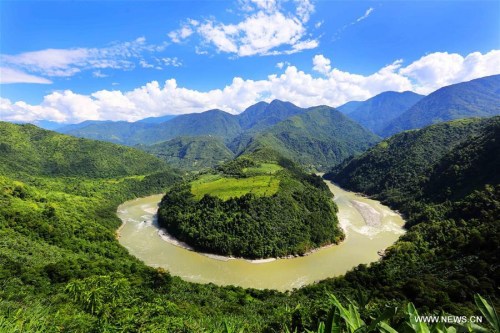
File photo taken on Dec. 6, 2014 shows the big turn of Yarlung Zangbo River in Medog County, Nyingchi City, southwest China's Tibet Autonomous Region. (Xinhua/Liu Fengying)
Mineral resource exploration in Tibet has caused damage, it said, citing the wanton disposal of mineral waste and the increased risk of soil erosion and landslides.
In order to protect this fragile environment, the regional government banned mining of gold dust on Jan. 1, 2006, and exploitation of iron sand on Jan. 1, 2008.
Forty mining companies in Tibet that failed to meet environmental standards have been closed since 2010. Moreover, by 2010, areas with registered mining rights covered only 749.62 square kilometers, less than 0.1 percent of the autonomous region's total area thanks to tightened controls.
Though it blamed people for increased environmental pressure, the report also lauded the positive results of environmental protection programs since the 1990s.
Ecological protection measures included in the design and construction of the Qinghai-Tibet Railway, for example, ensured the project was environmentally sound, the report said.
In the five years since the train route opened, the environment along it is already showing healthy signs of recovery, it said. "Parts of the region are close to, or even better than, the condition of natural areas in the surrounding regions."
"Though transportation, tourism and mining have inevitably affected parts of the plateau, it should be noted that Tibet's energy consumption mainly relies on clean energy and it has a service-dominant industrial mix, which means less pollution compared with densely-populated areas," Xu said.
THE FUTURE IS GREEN
The report warned that landslides, torrential floods and perpetual snow are expected to increase, and fires will be more difficult to prevent and extinguish.
In response, scientists called on the central government to increase investment in ecological protection, and urged the local government to prioritize environmental concerns when mapping out economic and social development plans. They suggested that a model green zone be established in Changtang, which will be a safe and clean habitat for wild animals such as Tibetan antelopes and yaks.
Since the area is important to environmental change in East and South Asia, the report proposed that a model of green development and enhanced environmental protection be drafted for the area.
"The Tibetan plateau could be [...] maintained if humans continue to exert a positive influence," the report said.
The institute describes the Tibetan plateau in its report as the areas mainly in southwest China's Tibet Autonomous Region, with an average altitude of over 4,500 meters and an area of more than 1.2 million square kilometers.
More than 70 specialists from China, the United States, Sweden and Canada started working on the report starting in 2012.


















































